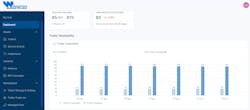LOUISVILLE, Kentucky—If you look up “marketplace” in the dictionary, you’ll get a couple of definitions: One, from the very earliest days of human commerce, refers to an open space where people met to exchange goods; think of the town square and the local trade fair. The updated version is less quaint, capturing a modern sense of efficiency, even urgency: the arena of competitive or commercial dealings.
The new Wabash Marketplace is designed to be a little bit of both, yet fully digital and connected, as Wabash representatives touched on in several presentations during the Wabash Ignite conference.
In short, as Ian Walters, Wabash's director of business development, explained, Wabash Marketplace is “a unified digital experience.” Such terminology might sound impersonal, but the new platform is built to be exactly the opposite.
“This experience is going to be unique,” Walters said, launching his demonstration for Ignite attendees. “It will be based off of your persona, or what customer type you are, or what role you play within your company.”
The platform is being developed as, essentially, the digital town square for the Wabash community, or “ecosystem,” as the company refers to its collaborative network of suppliers, dealers, and customers. And everyone’s personal experience is customized to provide the information he or she needs, for whatever role one has in this ecosystem.
Asset management
In the Asset Management area of the Marketplace, for example, fleet customers can “stay on top of performance” by tracking equipment condition and utilization, Walters explained.
“This is where you can partner with us, with our ecosystem partners, as we build out parking and storage solutions on a short-, medium- and long-term basis,” he said. “This is where you can come, once you get to the end of the useful life of that trailer, when you want to trade it in—and Wabash will help broker the sale of that trailer, and then will help get you into, hopefully, a new trailer with Wabash.”
The platform plays an especially important part for Wabash Trailers as a Service customers: Marketplace is where to find needed capacity, reserve trailers then manage the assets through the included telematics package, and keep tabs on maintenance and repairs—right down to schedules, repair history, costs, and more.
See also: Trailers as a Service: Capacity now
Parts e-commerce
Another key feature of Wabash Marketplace is access to the nationwide parts network, with the aim of building out a seamless and efficient e-commerce platform.
Similarly, “dealers can see everything from placing their quote all the way to delivery,” Karmine Yu, Wabash senior director of product for Wabash Marketplace, explained to FleetOwner.
“Visibility into their trailer orders is one of the things that dealers have always asked about,” Yu said. “Currently, it's spreadsheets; it's calling people. So that’s one of the things that we targeted.”
And, getting back to the unified digital experience concept, Wabash Marketplace is the new “central hub,” and users now log in only once to access what had been numerous applications, Yu continued, and each user’s suite of applications is based on his or her needs.
Suppliers, likewise, will have access to the appropriate set of applications as the platform is designed to serve as a true “two-sided marketplace,” streamlining parts distribution.
“Ultimately, we want to meet the customer where they're at,” Yu said. “So, if they don't have a sophisticated system, they could use Wabash Marketplace, but we could also take that data and integrate it into their own platform.”
An evolving ecosystem
Wabash Marketplace has roots in the company’s parts e-commerce development programs, Anna Brown, Wabash VP of strategy and digital transformation, told FleetOwner.
“A great starting point has been with our dealers because we can get real-time feedback from them—to help us iterate, help us create, and continue to develop our product,” Brown said. “As we roll it out to more and more different types of customers, we really have an outstanding product.”
So Wabash Marketplace really is an old town square—except now it's digital, global, and connected?
“The goal, the vision, is that we do truly build a marketplace where you're bringing in multiple buyers, multiple sellers. You're bringing your parts experience, and you're bringing an ability to manage together,” Brown said. “And for those that have the desire to have an asset subscription model, the data that they need is all folded into the Marketplace."
“We have different ways we're approaching it, but for our customers, they should feel one, seamless experience.”
Wabash has contracted FleetOwner to provide in-depth coverage of Wabash Ignite 2024. Some of the above content was reviewed and approved by Wabash before publication.
About the Author
Kevin Jones
Editor
Kevin has served as editor-in-chief of Trailer/Body Builders magazine since 2017—just the third editor in the magazine’s 60 years. He is also editorial director for Endeavor Business Media’s Commercial Vehicle group, which includes FleetOwner, Bulk Transporter, Refrigerated Transporter, American Trucker, and Fleet Maintenance magazines and websites.
Working from Beaufort, S.C., Kevin has covered trucking and manufacturing for nearly 20 years. His writing and commentary about the trucking industry and, previously, business and government, has been recognized with numerous state, regional, and national journalism awards.



